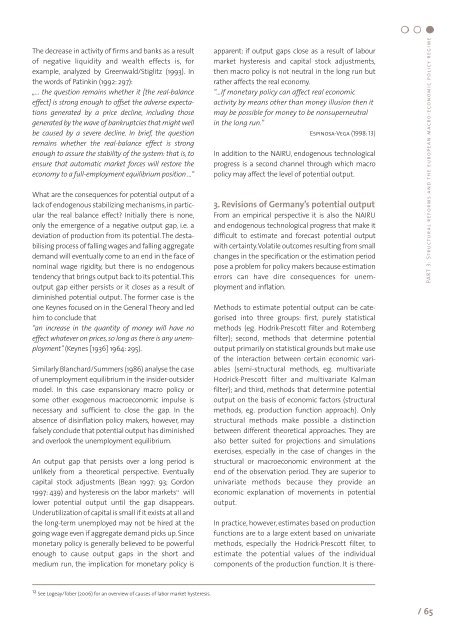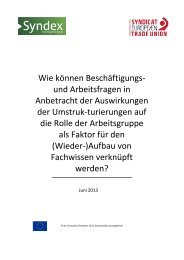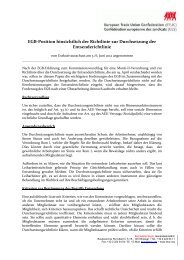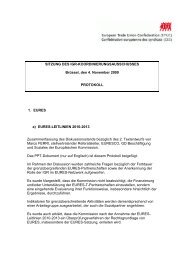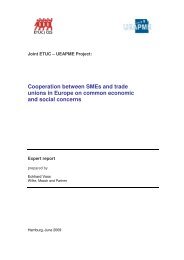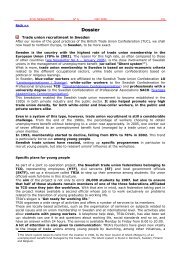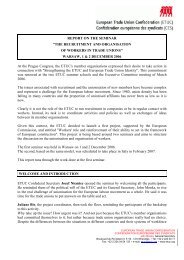Structural reforms and macro-economic policy - ETUC
Structural reforms and macro-economic policy - ETUC
Structural reforms and macro-economic policy - ETUC
You also want an ePaper? Increase the reach of your titles
YUMPU automatically turns print PDFs into web optimized ePapers that Google loves.
The decrease in activity of firms <strong>and</strong> banks as a result<br />
of negative liquidity <strong>and</strong> wealth effects is, for<br />
example, analyzed by Greenwald/Stiglitz (1993). In<br />
the words of Patinkin (1992: 297):<br />
„… the question remains whether it [the real-balance<br />
effect] is strong enough to offset the adverse expectations<br />
generated by a price decline, including those<br />
generated by the wave of bankruptcies that might well<br />
be caused by a severe decline. In brief, the question<br />
remains whether the real-balance effect is strong<br />
enough to assure the stability of the system: that is, to<br />
ensure that automatic market forces will restore the<br />
economy to a full-employment equilibrium position ...“<br />
What are the consequences for potential output of a<br />
lack of endogenous stabilizing mechanisms, in particular<br />
the real balance effect? Initially there is none,<br />
only the emergence of a negative output gap, i.e. a<br />
deviation of production from its potential. The destabilising<br />
process of falling wages <strong>and</strong> falling aggregate<br />
dem<strong>and</strong> will eventually come to an end in the face of<br />
nominal wage rigidity, but there is no endogenous<br />
tendency that brings output back to its potential.This<br />
output gap either persists or it closes as a result of<br />
diminished potential output. The former case is the<br />
one Keynes focused on in the General Theory <strong>and</strong> led<br />
him to conclude that<br />
“an increase in the quantity of money will have no<br />
effect whatever on prices, so long as there is any unemployment”<br />
(Keynes [1936] 1964: 295).<br />
Similarly Blanchard/Summers (1986) analyse the case<br />
of unemployment equilibrium in the insider-outsider<br />
model. In this case expansionary <strong>macro</strong> <strong>policy</strong> or<br />
some other exogenous <strong>macro</strong><strong>economic</strong> impulse is<br />
necessary <strong>and</strong> sufficient to close the gap. In the<br />
absence of disinflation <strong>policy</strong> makers, however, may<br />
falsely conclude that potential output has diminished<br />
<strong>and</strong> overlook the unemployment equilibrium.<br />
An output gap that persists over a long period is<br />
unlikely from a theoretical perspective. Eventually<br />
capital stock adjustments (Bean 1997: 93; Gordon<br />
1997: 439) <strong>and</strong> hysteresis on the labor markets 12 will<br />
lower potential output until the gap disappears.<br />
Underutilization of capital is small if it exists at all <strong>and</strong><br />
the long-term unemployed may not be hired at the<br />
going wage even if aggregate dem<strong>and</strong> picks up. Since<br />
monetary <strong>policy</strong> is generally believed to be powerful<br />
enough to cause output gaps in the short <strong>and</strong><br />
medium run, the implication for monetary <strong>policy</strong> is<br />
12 See Logeay/Tober (2006) for an overview of causes of labor market hysteresis.<br />
apparent: if output gaps close as a result of labour<br />
market hysteresis <strong>and</strong> capital stock adjustments,<br />
then <strong>macro</strong> <strong>policy</strong> is not neutral in the long run but<br />
rather affects the real economy.<br />
“…If monetary <strong>policy</strong> can affect real <strong>economic</strong><br />
activity by means other than money illusion then it<br />
may be possible for money to be nonsuperneutral<br />
in the long run.”<br />
Espinosa-Vega (1998: 13)<br />
In addition to the NAIRU, endogenous technological<br />
progress is a second channel through which <strong>macro</strong><br />
<strong>policy</strong> may affect the level of potential output.<br />
3. Revisions of Germany’s potential output<br />
From an empirical perspective it is also the NAIRU<br />
<strong>and</strong> endogenous technological progress that make it<br />
difficult to estimate <strong>and</strong> forecast potential output<br />
with certainty.Volatile outcomes resulting from small<br />
changes in the specification or the estimation period<br />
pose a problem for <strong>policy</strong> makers because estimation<br />
errors can have dire consequences for unemployment<br />
<strong>and</strong> inflation.<br />
Methods to estimate potential output can be categorised<br />
into three groups: first, purely statistical<br />
methods (eg. Hodrik-Prescott filter <strong>and</strong> Rotemberg<br />
filter); second, methods that determine potential<br />
output primarily on statistical grounds but make use<br />
of the interaction between certain <strong>economic</strong> variables<br />
(semi-structural methods, eg. multivariate<br />
Hodrick-Prescott filter <strong>and</strong> multivariate Kalman<br />
filter); <strong>and</strong> third, methods that determine potential<br />
output on the basis of <strong>economic</strong> factors (structural<br />
methods, eg. production function approach). Only<br />
structural methods make possible a distinction<br />
between different theoretical approaches. They are<br />
also better suited for projections <strong>and</strong> simulations<br />
exercises, especially in the case of changes in the<br />
structural or <strong>macro</strong><strong>economic</strong> environment at the<br />
end of the observation period. They are superior to<br />
univariate methods because they provide an<br />
<strong>economic</strong> explanation of movements in potential<br />
output.<br />
In practice, however, estimates based on production<br />
functions are to a large extent based on univariate<br />
methods, especially the Hodrick-Prescott filter, to<br />
estimate the potential values of the individual<br />
components of the production function. It is there-<br />
PART 3: <strong>Structural</strong> <strong>reforms</strong> <strong>and</strong> the european <strong>macro</strong>-<strong>economic</strong> <strong>policy</strong> regime<br />
/ 65


